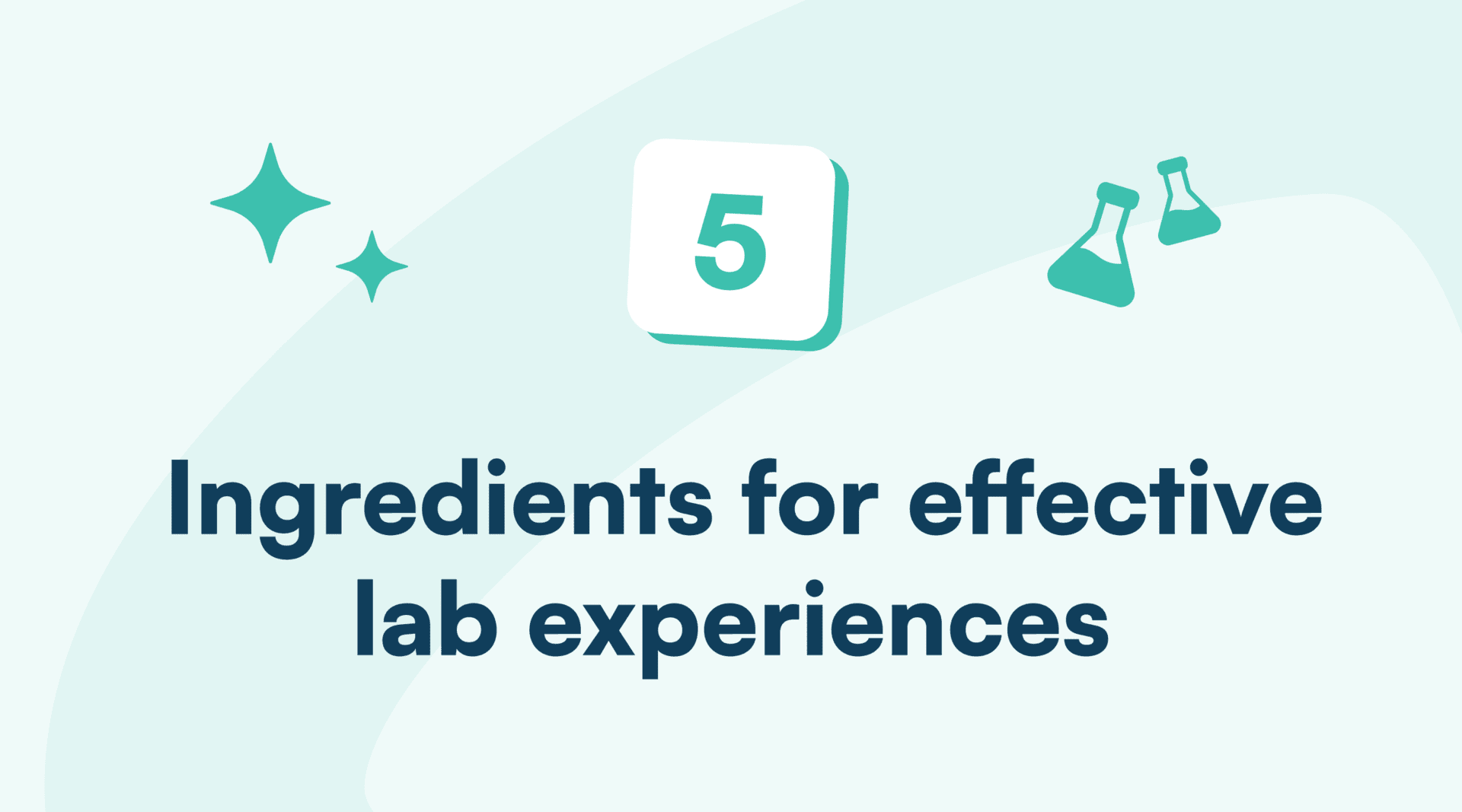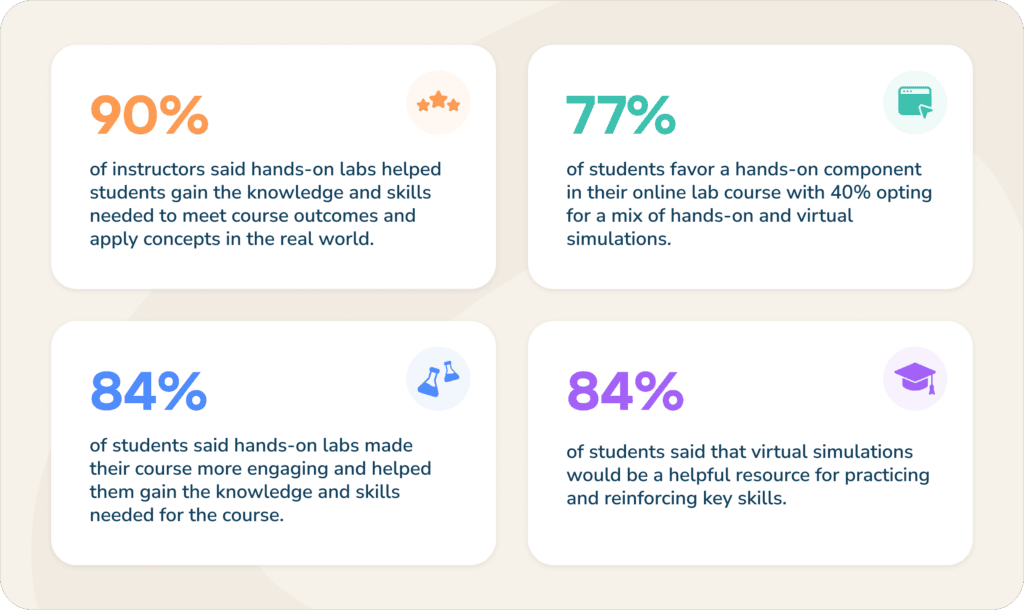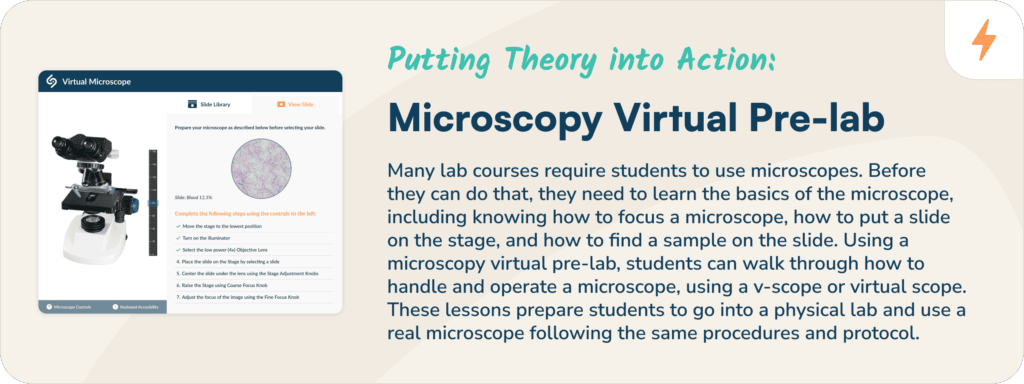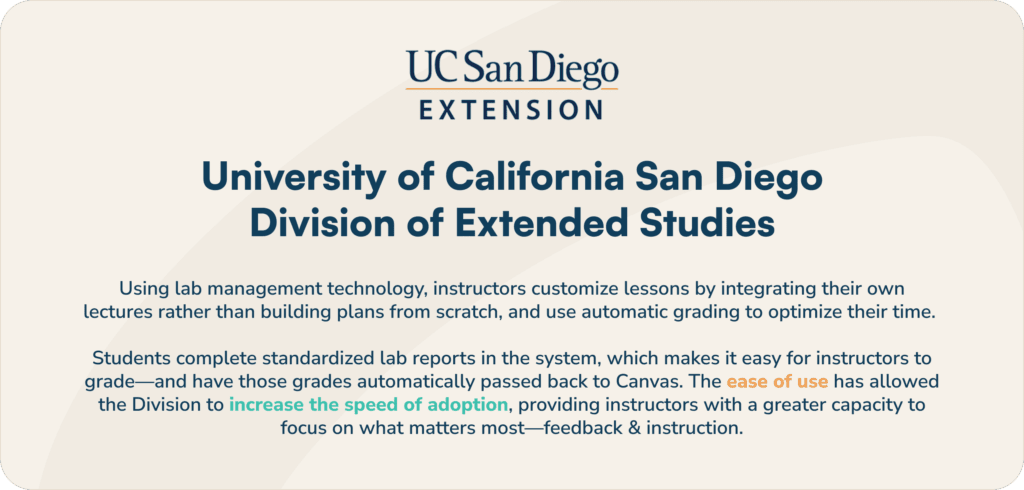Table of contents

Some students engage; others don’t; still, others participate in their own ways. Any way you slice it, every student needs the opportunities, tools, resources, guidance, and support to leave your course feeling prepared, confident in what they’ve learned, and able to apply it to the real world.
Online, on campus, or anywhere in between, all it takes is the right mix of ingredients to set your students up for success.
- Clear Expectations & Communication
- Strategic Blend of Lab Modalities
- Access & Affordability
- Constructive Feedback & Assessment Analytics
- Student Support
The Recipe for Greater Student Success in your Labs
Based on 30 years of experience with hundreds of programs across the country as well as two years worth of data from our Annual Lab Reports, for which we surveyed thousands of educators and students on their online and on-campus lab experiences, we’ve compiled a short guide of the 5 essential ingredients that significantly impact student success.
- Preheat with Clear Expectations & Communication
Like the start of any great dish, we have to preheat the oven. How you set the stage for your course, especially important for online courses where you can’t speak directly to students like you can in a classroom, can set the tone for students’ level of engagement. That’s why providing clear expectations and guidance for how and when to complete course activities is important. Always be sure at the start off the course and at the top of every lesson to:
- Remind students how and where to find course material, and explain how that material aligns with the objectives of the course.
- Keep due dates for important labs and assignments top of students’ minds and make sure a syllabus and online rubric tied to the course’s learning outcomes are highly visible.
- Anticipate potential questions from students and prepare a quick FAQ resource for experiments — especially helpful for students new to lab courses.
And just when you think you might be providing too many resources or answering too many questions, consider that each student coming into your course has a different level of requisite knowledge. For example, while some students may have handled some of the materials in your labs previously, others may struggle to even identify the name of those materials. For online courses where you’re not in the physical lab to provide an orientation, use tools like online annotation to provide a resource that makes identification easier for them and serves as a refresher for others.
As one anatomy & physiology instructor shared in their 2024 Annual Lab Report survey response, “I use videos and weekly LMS video announcements to connect learning with objectives and assignments, providing material to students one week in advance to maintain open communication while setting high expectations. Clarity is key in your interactions with students.”
For Ricki Burnett Arndt, Laboratory Specialist at Utah State University, Brigham City and the 2024 Golden Goggles Student-Centered Educator of the Year, she said “When students have their learning outcomes provided at the very beginning of the activity, lab, or lecture, there’s no guessing game. That helps build their confidence going into it—they know what they’re supposed to get out of it. And by following those outcomes when you’re building an assessment, that builds that trust with the students that you’re not going to put something on an assessment they didn’t know was important.That is one of the biggest things that has helped students feel prepared.”
- Add in a Strategic Mix of Lab Modalities
When we asked 295 science educators and 1,878 students what their biggest challenge was in their online and on-campus labs, not only did these groups align, an overwhelming majority of all both cited this as a top challenge:
A Lack of Student Preparation, Confidence & Engagement
In fact, nearly 80% of administrators and instructors said that students aren’t prepared because they lack prerequisite knowledge needed for their courses, while nearly three-fourths of both groups also cite student engagement as a key challenge. Similarly, about half of students said a lack of confidence was their biggest challenge.
This is where the importance of your lab modality comes into play.

Prioritize Hands-on Labs & Fold in Virtual Labs
Research by The American Chemical Society reinforces the need for hands-on learning in science. Students who engage in hands-on laboratory experiences have a greater opportunity to develop problem-solving and critical-thinking skills, as well as gain exposure to reactions, materials, and equipment. The ACS research also shows that sustained investment in hands-on experiences help inspire students to further their education and prepare them for high-technology careers by fostering skills sought by potential employers.
That’s why administrators and instructors agree that hands-on labs in online courses are effective when it comes to ensuring quality, supporting student learning, and re-creating an experience comparable to on-campus.

The Benefits of Hands-on Labs
Using hands-on labs as a part of your online course has a significant impact on student preparation and learning, as well as additional benefits. As one microbiology department chair said in the 2024 Annual Lab Report, “Using at-home hands-on lab kits are great for online students to learn the same concepts at a microscale.” Echoing those sentiments, one online Anatomy & Physiology instructor pointed out, “Online hands-on labs are rigorous and force students to work for a grade. They have to do the lab and participate to earn points.”
- Create a high-quality, rigorous learning experience: Hands-on labs allow students to physically conduct experiments at home using lab kits. You’ll give students the opportunity to learn the physical & critical thinking skills necessary to run experiments, putting them in a position to navigate problems, analyze results, and better master course concepts—all of which work to help students gain the knowledge and skills they need to feel prepared and confident in their abilities.
- Increase inclusivity by activating all the different styles of learning and reaching more students.
- Increase the likelihood of transfer-ability: Incorporating a hands-on component elevates the course and helps ensure students can use your course for transfer credit. Be cautious with relying solely on virtual simulations in your courses because while they can improve student engagement and reinforce key concepts, they won’t provide a hands-on experience, and as a result, courses often don’t meet transfer-ability requirements.
Virtual Simulations
Still, virtual simulations can reinforce learning and complement hands-on labs. As one student shared, “Virtual simulations help me learn due to less fear of critical errors, and I can repeat experiments until I get it, which helps me learn better.”
When hands-on and virtual are used together, you’ll be able to appeal to an even broader set of learning styles, leading to deeper engagement, greater reinforcement, better preparation, and a more meaningful learning experience.
But beware. Relying solely on virtual simulations won’t help prepare your students in the way hands-on labs do. 63% of the students surveyed in the Annual Report said they would have felt more confident applying what they learned in the real-world if they had the opportunity to do hands-on labs at home. What’s more, 55% said they would have learned more if they did hands-on labs.
The Benefits of Virtual Simulations
That’s why it’s important to leverage an effective mix of virtual and hands-on labs. This allows you to take advantage of the benefits that come with virtual simulations.
- Allow students to observe the unobservable. Virtual simulations can portray abstract objects, such as light rays, that students cannot see in a physical lab, giving them additional ways to visualize nebulous concepts. Climate change and evolution, for example, can be simulated using an online lab but would be difficult to teach physically.
- Reinforce and supplement learning and allow for repeatability & failure. Unlike the finite materials of a physical lab, it doesn’t matter, except in time, whether a student runs a digital experiment one time or 20 times to get the desired result. With each simulation, students can manipulate variables, run the experiment, and immediately see the results, especially important for struggling students or for learning from mistakes. Virtual simulations are a valuable low stakes way to encourage growth. When labs don’t turn out as expected, students will learn new skills and figure out ways to course correct—an experience that proves to build confidence.
In the end, providing students with different ways to practice skills and engage with concepts throughout your course will more deeply engage them, as well as help them feel more confident and better prepared to apply what they’ve learned—setting them up for greater post-course success.

Pre-Lab Preparation for On-Campus Labs
With direct access to instructors and easier opportunities to collaborate with classmates, the on-campus experience is particularly helpful for higher-level courses. So when we asked instructors what they do to help bridge the confidence and preparation gap in their on-campus lab courses, two-thirds said they use written pre-lab assignments as a way to better prepare students, and the vast majority (90%) thought they were effective.
That said, despite their widespread use and perceived effectiveness, written pre-lab assignments seemingly don’t address the top challenge cited by administrators, instructors, and students alike: a lack of student & confidence during on-campus labs.
But there’s a solution to this disconnect. Consider incorporating virtual simulations (trial experiments) into your pre-lab assignments. Why? 83% of students said that a virtual pre-lab that included a review of lab procedures, summary of safety protocols as well as a simulation of a trial experiment would help them feel more prepared for an in-person lab.
Using trial experiments during pre-labs is a way to connect and emphasize to students that experimental science is the basis for the models they learn about in lecture. Like virtual simulations in an online lab course, these pre-labs give students an opportunity to repeat experiments in a low-stakes environment and more deeply engage with course material. Virtual pre-labs that include simulated trial experiments can:
- Train students in conducting experiments and addressing problems
- Save valuable lab time by introducing techniques, equipment/materials & safety protocols
- Reinforce theoretical concepts
- Make students feel better prepared and more confident going into experiments
Students can go at their own pace and practice navigating problems and repeating the simulation as many times as needed—all before walking into the campus laboratory. They will feel more prepared and confident in their abilities when they enter your lab, having gone through a virtual simulation of the lab and seen safety measures and lab techniques in action—extremely valuable for non-majors or for those students taking a lab for the first time.

- Throw in a Dash of Better Access & Affordability of Course Materials
Whether online or on-campus, the cost of course materials remains a challenge. In 2023 research from Bay View Analytics, 78% of administrators said they were concerned with the cost of materials for students. Nearly half of the faculty they surveyed said they’re using open educational resources materials or supplemental course materials.
Similarly, deans and department chairs surveyed for the 2024 Annual Lab Report also cite measures they use to address the affordability of lab courses, including providing access to low-cost/free lab materials and implementing Open Educational Resources (OER), such as OpenStax.
From textbooks to additional materials, PDFs, and resources, costs can start to add up. On top of that, when your instructional materials are siloed, or have to be accessed in different ways through different systems, it creates confusion for students and can make deeper engagement with the material more difficult.
Consider using OpenStax textbooks integrated within your lab management platform. OpenStax’s free, high-quality, peer-reviewed, openly licensed textbooks are accessible right from Science Interactive’s lab platform, allowing you to use high-quality instructional materials and lab curricula without any additional fees or cost to students. Students have easy access to the text, especially at the moments when it matters most—when completing labs. They’ll find answers and get unstuck faster when up against a problem, and be able to better connect theoretical concepts to what they’re learning in the lab.
“Having lab materials and the OpenStax text on the same platform improves the student’s learning experience and grasp of the materials. Seamless integration of hands-on labs, virtual simulations, and the textbook makes it easier for students to connect what they are reading to what they are doing in lab, and this reinforcement means that they can better retain the concepts. This also makes it easier for instructors to assess student learning and see where each student is struggling—offering the instructor the opportunity to remediate the student more quickly and ensure success,” says Amy Daniels, Assistant Professor at Greenville Technical College.
- Bake in some Constructive Feedback & Assessment Analytics
Student success depends on continuous feedback. Without feedback loops, it’s difficult to address students as individual learners, let alone improve course delivery to engage students both intellectually and emotionally.
Studies have demonstrated that ongoing quality feedback can work to motivate students to continue engaging. In one study that looked at delayed versus immediate feedback, researchers found that students who were given immediate feedback showed a significantly larger increase in performance than those who received delayed feedback. Similarly, research out of the University of Minnesota showed that students who received a large amount of constructive and immediate feedback were better able to comprehend the material they had just read.
Be sure to use a lab management platform that easily enables you to provide ongoing feedback to each student throughout the course. With tools like this, you can leverage question banks, test your knowledge modules, assign self reflections on learnings, and use multiple choice quizzes enabled with automatic grading so grades sync directly with your LMS—giving you different opportunities to monitor student progress and give feedback.
Plus, with platforms like this, you have access to assessment analytics that can help you identify students who may be falling behind in certain areas—giving you the opportunity to provide the extra layer of guidance that gets them back on track.

On the flip side of it, feedback for you, as the instructor, is critical. Consider using pre, mid, and post course surveys or evaluations, polls, informal online or classroom Q&A, or online discussions to get a pulse from your students on the lessons, labs, and how they feel they’re progressing.
Professor Hiranuma, Earth Science instructor from West Texas A&M University, delivers all of his online labs with this in mind: “The more you offer, the more you learn.” That’s why he conducts surveys and collects expectations from his students, asking students for their feedback and what they expect their biggest challenges to be that semester. With this information, he’s able to provide more personalized support and feedback for each student—and continue improving how he delivers his lab courses.
- Season Liberally with Student Support
Finally, don’t underestimate the power of support. Double down on different levers to guide students through your course successfully.
Instructors surveyed for the 2024 Annual Lab Report said they use a combination of the following tactics to better support students:
- In-office & virtual office hours
- Using discussion boards so students can interact
- Enabling peer collaboration (assigning students to groups)
- Providing pre-recorded videos and models prior to the lab to familiarize students with key concepts
- Using class time & lectures to review and reinforce key material
- Pre-lab assignments & quizzes
- Engaging TAs for additional support
And when we asked students what supplemental resources would help support their success, they said:
- Virtual simulations (86%)
- Virtual simulations as a practice lab (84%)
- Asynchronous videos (82%)
- Peer collaboration (55%)
In the end, students want to engage, and more importantly, they want to be successful in their courses. Invest time in providing students with the support and guidance they need, using in-person or virtual office hours, recorded videos & tutorials, supplemental online activities, and opportunities to collaborate with peers either in small groups or in pairs. These tactics can help boost student confidence and better prepare them for labs both online or on-campus.
Supporting Student Learning Online & On-campus
As the lines between online and on-campus learning continue to blur, programs are looking to different avenues to deliver these learning experiences. Fully online and hybrid courses are proving to be some of the most powerful ways to expand course offerings to additional pools of learners, including those seeking career advancement, professional development, or just starting their post-secondary studies, which presents an opportunity to create an effective and authentic learning experience comparable in quality to the on-campus lab experience.
To do that, combining the right mix of lab modalities with strategies proven to engage students as well as LMS-integrated lab management technology will keep your program competitive and supercharge the effectiveness of your course. The most effective instructors will be able to adapt to the way their students learn, introduce a variety of approaches throughout their course, and as a result, deliver an engaging and meaningful experience from wherever students learn—now that’s a recipe for student success.